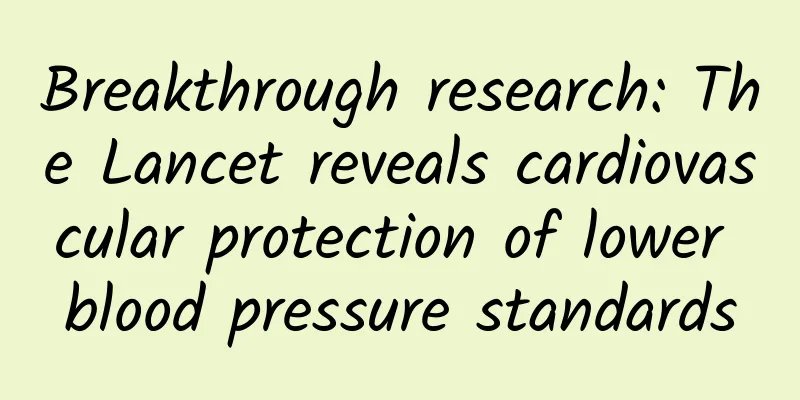Breakthrough research: The Lancet reveals cardiovascular protection of lower blood pressure standards

|
summary: Recently, a breakthrough study published by Chinese scholars in The Lancet showed that controlling systolic blood pressure below 120 mmHg can significantly reduce the incidence of cardiovascular events in patients with high cardiovascular risk. This study challenges the traditional blood pressure control standards and provides a new perspective and method for hypertension management. However, the study also pointed out that stricter blood pressure control may increase the risk of certain side effects, and the pros and cons need to be weighed in clinical practice. Hypertension is a major health problem worldwide, especially in China, where a large number of patients have abnormal blood pressure. Recently, Chinese scholar Dr. Jiamin Liu and his team published a new important study in The Lancet, exploring the effect of lowering systolic blood pressure to less than 120 mmHg compared with less than 140 mmHg for patients with high cardiovascular risk. This article will explain to you the key findings of this study and its practical guiding significance for the management of hypertension. 1. Background of the study Hypertension is an important risk factor for cardiovascular disease, and controlling blood pressure is essential for preventing cardiovascular events. However, for patients with high cardiovascular risk, especially those with diabetes and previous stroke, the optimal blood pressure control target has been controversial. The Chinese team's study aims to clarify whether setting a systolic blood pressure target of less than 120 mmHg is better than setting it below 140 mmHg. 2. Research Methods This study by the Chinese team is an international open-label, blinded randomized controlled trial that included 11,255 patients with high cardiovascular risk from 116 hospitals or communities in China. Participants were randomly assigned to an intensive treatment group (target systolic blood pressure less than 120 mmHg) or a standard treatment group (target systolic blood pressure less than 140 mmHg). The main scope of the study included a comprehensive outcome of myocardial infarction, revascularization, heart failure hospitalization, stroke, or death from cardiovascular causes. 3. Findings and Results During the average follow-up of 3.4 years, the incidence of major cardiovascular events in the intensive treatment group was significantly lower than that in the standard treatment group (9.7% vs 11.1%, HR 0.88, 95% CI 0.78-0.99, p=0.028). This shows that setting the systolic blood pressure target below 120 mmHg can indeed significantly reduce the occurrence of cardiovascular events. However, the incidence of serious adverse events such as syncope was higher in the intensive treatment group (0.4% vs 0.1%, HR 3.00, 95% CI 1.35-6.68). IV. Practical suggestions A. Regularly monitor blood pressure: Especially for patients with high cardiovascular risk, regular monitoring of blood pressure can help to adjust treatment plans in a timely manner. For example, you can use a home blood pressure monitor, measure once in the morning and once in the evening every day, and simply record it in a blood pressure diary. B. Individualized treatment: Although intensive antihypertensive treatment has shown significant cardiovascular protective effects, it is also accompanied by certain risks. Patients should choose appropriate antihypertensive targets according to their own conditions under the guidance of a doctor. C. Healthy lifestyle: In addition to drug treatment, a healthy lifestyle such as a proper diet, moderate exercise, smoking cessation and alcohol restriction are also important measures to control blood pressure. It is recommended to do 30 minutes of moderate intensity exercise every day, such as brisk walking, cycling and other moderate exercise. D. Diet adjustment: Reduce salt intake, no more than 5 grams of salt per day. Eat more fruits, vegetables and healthy grains, and reduce the intake of bad fats and high-sugar foods. E. Balancing benefits and risks: The study found that the incidence of syncope was higher in the intensive treatment group (0.4% vs 0.1%). We know that syncope may lead to falls and injuries, especially for elderly patients. Therefore, when gradually lowering blood pressure targets, possible side effects need to be closely monitored. Adjusting the treatment plan according to the patient's age, physical condition and other risk factors to balance the benefits of lowering blood pressure and potential risks should be the first priority. F. Gradual implementation: For patients who need to lower their blood pressure to lower levels, the doctor may take a gradual approach, gradually lowering the blood pressure goal while closely monitoring the patient's response and possible side effects. V. Conclusion The study by Dr. Jiamin Liu and his team provides a new evidence for the management of hypertension, especially in patients with high cardiovascular risk. It was found that setting the systolic blood pressure target below 120 mmHg can significantly reduce the occurrence of cardiovascular events, but attention should still be paid to possible side effects during the operation, such as an increased risk of syncope. This emphasizes the importance of individualized treatment, and doctors need to weigh the benefits and risks of antihypertensive treatment based on the specific circumstances of each patient. As a country with a large number of patients with hypertension, China's research results in this field are particularly important. This study published in The Lancet demonstrates the strength of Chinese scholars in the field of international medical research and contributes to reducing the risk of cardiovascular disease. It not only provides new guidance for clinical practice, but also points out the direction for future hypertension research. Ultimately, while this research provides us with valuable new insights, each person's situation is unique. Patients should work closely with their doctors to develop a blood pressure management plan that is best for them based on their individual health status, risk factors, and quality of life considerations. |
Recommend
What are the characteristics of girls' voice change period?
Girls' voice change period usually occurs whe...
How many days after menstruation is it harder to get pregnant when having sex?
Menstruation is a normal physiological cycle for ...
Did Li Yutong have a miscarriage? How did Li Yutong get together with her new boyfriend?
On February 5, Li Yutong took the initiative to c...
Causes of hot and cold spells during menopause
Many people may think that menopause is a conditi...
Detailed diagram of the location of the posterior fornix
Many women don't know their bodies very well,...
Are mouse repellers harmful to pregnant women?
We know that ultrasonic rodent killers use ultras...
Are breast nodules with clear borders benign?
Once breast nodules appear, the first thing patie...
What can women eat to get better quickly if they have hot blood?
Blood heat refers to a condition in which the bod...
Brown discharge a week before period
The key reason for brown discharge before menstru...
This is how you take care of your breasts. Do you do this?
Breast care is extremely important for female fri...
The "little thing" of drinking water is really not that simple. How should you drink 8 glasses of water a day?
As we all know, water is one of the most importan...
How to prevent arthritis?
How to prevent arthritis? ►Cold is not an importa...
Can I sleep on my left side if my water breaks?
Speaking of prenatal check-ups, I believe every p...
What numbers are better for Christmas red envelopes in 2020? What numbers are better for Christmas red envelopes in 2020?
As we all know, Christmas is a very popular Weste...
Advantages and disadvantages of contraceptive pills
Contraception is a very important matter, and it ...









